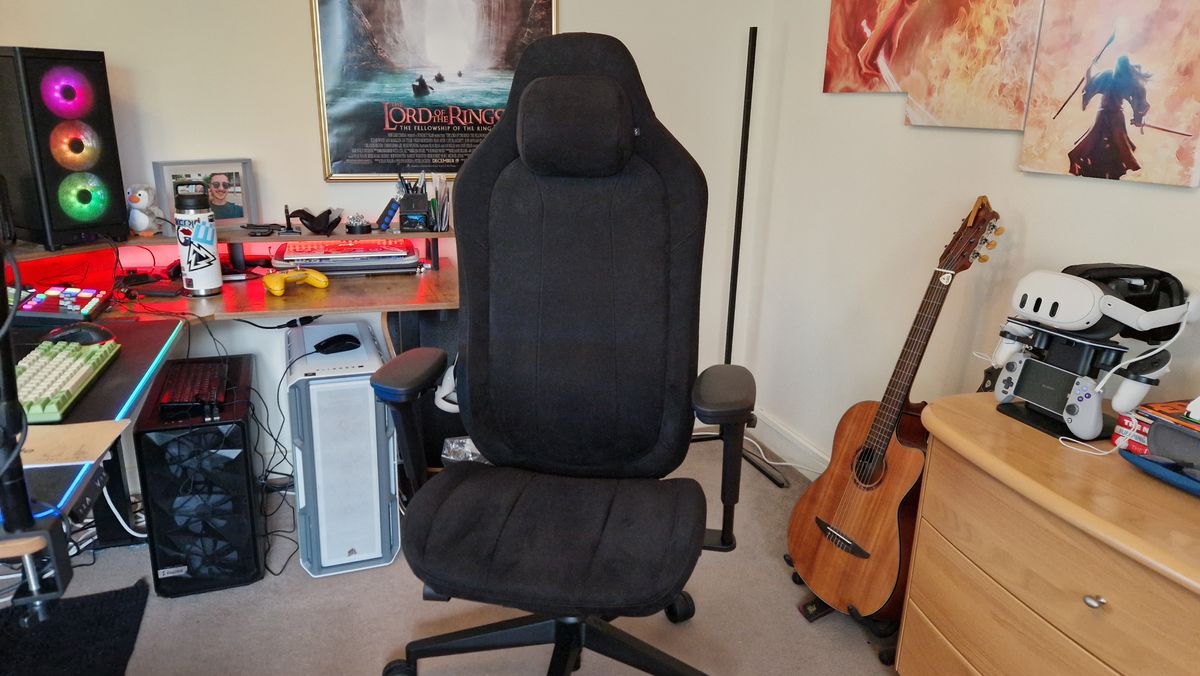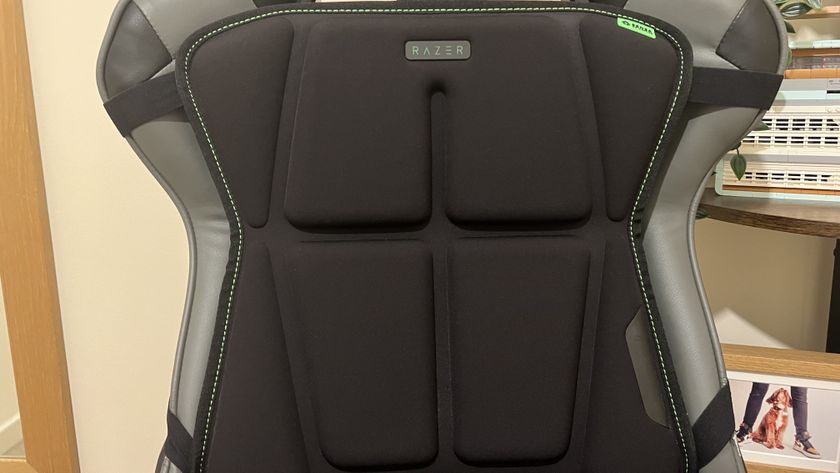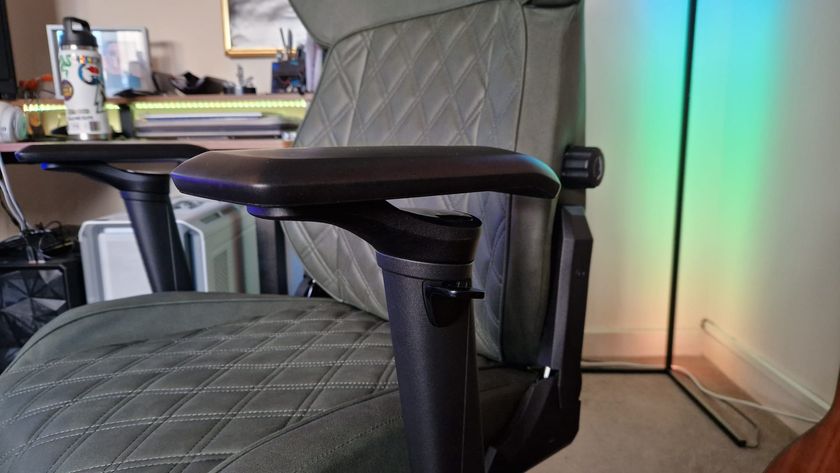12DOVE Verdict
I can scarcely believe how good the Fractal Refine is, considering this brand has never made a gaming chair before. In almost every way, it’s a perfect all-rounder that looks a million dollars while being adjustable, comfortable, and ergonomic. Other gaming chair brands should take note because what Fractal Design has achieved here is very impressive indeed.
Pros
- +
Good range of cosmetic, mesh, and fabric options
- +
Excellent armrests
- +
Nice mix of comfort and ergonomics
- +
Stunning looks
- +
Ability to slide into a deeper sitting position
Cons
- -
A minimalist approach means there isn’t much cushioning
- -
Armrests can slide out of position too easily
- -
Adjusting controls could be better
Why you can trust 12DOVE
The Fractal Refine is the first-ever gaming chair from a luxurious Swedish brand that’s known best for its excellently thought-out PC cases. For a first crack at a new product, the Refine is bold, it’s not afraid to do things differently, and it’s a damn impressive end result. It might not try to be the best in any one specific area, but that allows it to be a really strong all-rounder.
The best gaming chairs are often pretty similar. They sport a racing chair cutout in their general shapes, some adjustable armrests, maybe a lumbar and head cushion, and all of them try to blend comfort with ergonomics. It’s clear that Fractal has done its homework because all those non-negotiables are present here. Not only that, the brand has looked at what does and doesn’t work in the current talent pool and has tried to improve upon it - perhaps hinting at its namesake, the Refine.
Also impressive is the fact that Fractal Design has supplied mesh and fabric versions of its first seat - putting to bed the idea that other brands should be making separate products depending on which side of the market they’re targeting. Whether you go for the Light or Dark Fabric model, or the Light or Dark Mesh model, you’ll pay the same $549 / £474 for the Refine. If you opt for the premium Alcantara version I’ve been testing, you’ll need to set your budget higher, to the tune of $899 / £779.
Design & Features
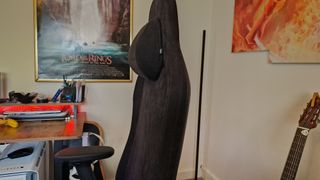
I really don’t want you to think I’m weird for what I’m about to say, but I don’t know any other way to sum it up. The Fractal Refine is a very sexy gaming chair. Still reading? I hope so because even the Herman Miller X Logitech Embody doesn’t look this stylish to me, and I want to try to do it justice. The Alcantara model has this rich black tone to it that really draws the eye in with its matte texture. There aren’t Frankenstinean stitching lines across the upholstery, and this means the only defining lines when you look at the chair as a whole are its various outlines. It’s an almost Moebius-visual effect which I never get tired of seeing at my desk.
The shape of the Refine isn’t a million miles away from the traditional racing chair cutout we see all too often, but it's blended here with ergonomic allure as it stretches a bit taller than rival chairs. There’s subtle curvature in the shoulders that make it seem dignified, and yet it’s still recognizable as something more than a bland old office chair.
The backrest is where its Swedish sense of minimalism comes up short for me though, because, in its attempts to cater to both the mesh and cushioned sides of the market, it feels like it’s missing the best of either. The back doesn’t have the breathability of mesh, but it doesn’t have substantial cushioning to make it feel as comfortable as something like the Boulies Ninja Pro.
The seatbase is more than substantial though, and its adjustment controls are integrated into the paneling on its sides, which is a nice design choice that means there are no awkward levers poking out at off angles. As nice as this is, function does suffer a bit. When you’re sitting above them, they can be harder to find. They also don’t have the best action, so when you pull one out you have a slight moment of doubt where you ask “Am I breaking something, or is this thin bit of plastic supposed to fold out the way?”


Your standard recline features are here - the chair’s back can lean to 125°, and there’s integrated lumbar support you can adjust to what suits you and your body. It is a tad annoying that you need to stand up and spin the chair around to access this, but that’s the case for the majority of lumbar twizzlers on the market. Like any office-style chair, you can also make the Refine go higher or lower. The Armrests can move inward, up and down, and even change angles to best reflect your position. This is all great, but what’s annoying as hell is that they slide forward and back without the use of a catch, button, or lever. That often results in you switching positions and accidentally clicking them a few notches out of place.
The headrest cushion is an unexpected delight as well. It doesn’t opt for the magnetic tech in Secretlab’s chairs and leaves out the elasticated strap used by a lot of other brands. The cushion here slots into the backrest with two metal hooks, which allow it to slide up and down. You can then take the headrest off completely thanks to a handy eject button on the top of the backrest.
There are, however, some unexpected adjusting features that you won’t find elsewhere. For example, there’s the ability for the seatbase to slide forward, allowing you to actually shift into a more relaxed position at a desk without ruining the chair’s ergonomic potential. You can adjust the seat depth too, which is an added bonus if a brand isn’t making slightly larger models of its chairs to suit gamers with larger frames. There’s tilt tension adjustability, which increases or decreases the resistance you feel when leaning back. I fiddled with this many times, but honestly never felt different tensions. Maybe this is my problem, but I suppose it’s a nice way for people to control how much they need to lean back to adopt a more comfortable position.
Assembly
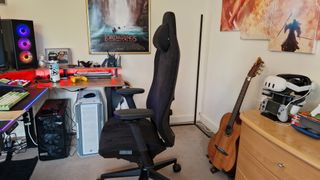
One of the most important ways we test gaming chairs here at 12DOVE is by assembling each seat ourselves, and determining whether a helper is needed or not. Assembly instructions vary wildly in gaming chair realms - some opt for a large placard that drapes over the top of the chair in the box, others print out colored A4 sheets, and some give you a QR code and let you fend for yourself.
Having just built a gaming PC in one of Fractal’s Meshify Cases, I can say that there are definitely design cues this brand is bringing over from its Swedish counterpart, IKEA. Instructions here come in the form of a handy user guide booklet, but there are no words used other than the basic step title. “Attach Seat Assembly”, and “Attach Armrests” are fine, but some light color coding wasn’t enough to explain that you have options for where to actually attach certain screws. I found this ambiguity with Fractal’s PC case instructions too. Diagrams and some dotted lines can sometimes assume understanding that isn’t always present for first-time builders - I’ve thrown together plenty of gaming chairs, and even I got stumped a few times during the Refine’s assembly, wondering if I’d taken a wrong turn somewhere or used a wrong screw. For folks who aren’t as accustomed to building flat-packed gaming furniture, a few more words or even just some more clarity in the images wouldn’t go amiss.
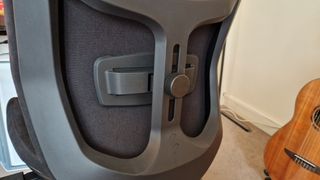
Luckily, maneuvering the individual parts of the chair was easy enough, and nothing felt too heavy for one person to sort on their own. The hollowed-out castors don’t click into place quite like the assembly instructions show, but they slot in just fine once you turn the wheelbase the correct way up.
I did have to do a reassembly of the Refine following an event I wish I caught on camera. Attaching the backrest to the chair involves fixing four bolts into place - this is rather confusing since the instructions only say you should have two backrest screws, but there are another two in the backrest already when you unbox it. One of the first times I properly sat down in the assembled chair and leaned back, I felt a slide, then a click, then gravity take over as I toppled backwards, my legs flying up in the air in an involuntary backflip. I’d love to say I knew exactly what caused the backrest to fall out of the seat assembly - I certainly thought I had screwed things down securely enough. After fixing the screws back into place a bit tighter, this didn’t occur again, but the instructions didn’t exactly inspire a lot of confidence I was doing the right thing. Safe to say, make sure you bolt things down securely before you recline in the Refine.
Performance
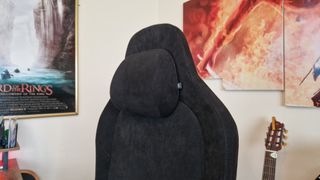
Coming from the Boulies Ninja Pro, one of the most plush and comfortable gaming chairs, part of me wants to argue that the Refine doesn’t have enough cushioning for the money you pay. I do feel that’s a valid bit of criticism because when you properly inspect the backrest, there really isn’t much there. For mesh enjoyers, that’s standard, but for anyone who wants a bit more bang for their buck, it’s hard to justify the money you spend on the Refine compared to leather options with more cold-cured foam under the hood.
It’s comfortable, even without an abundance of cushioning, and allows people to choose freely between mesh and upholstery...
Still, it’s really difficult to fault the Fractal Refine, because even without the plush cushioning I’d prefer, this is such a comfortable seat to sit in for hours at a time. I actually think this comes down to perfect ergonomics, because if that’s done correctly, you shouldn’t really notice it. Gaming chairs almost always try to combine comfort with good posture support, which is why they’re worth buying over office chairs. You’ll often find, though, that any given chair will do one better than the other - it’s a very difficult ratio to get right. Although I will occasionally get a numb rear-end sitting in the same position for too long, I think the seat base itself is plenty comfortable, and I think the ability to slide into a deeper position is a huge win for the Refine.
One thing I genuinely can’t get over is how brilliant the armrests are. Don’t get me wrong, the forward and backward sliding annoys me to no end, and I wish there was a way to lock them in place. Still, the amount of movement and fine-tuning you can do with them means you can set them exactly level with a desk, which I found was so beneficial for my aiming in first-person shooters like Hunt: Showdown. Having tested a Secretlab Titan Evo just before this, I found the armrests here to be much more malleable, which I think is a really underrated feature. There isn’t anything particularly special to these armrests in terms of comfort. There’s a squish to them, but they maintain a wide shape that cradles your forearms. Their wider shape is great though, particularly for bigger flicks of the mouse when gaming.
Should you buy the Fractal Refine?
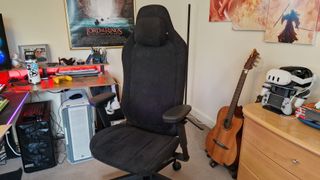
The Fractal Refine has a different feel to a lot of the gaming chairs I’ve tried, and I think it’s the different approaches Fractal Design has taken that meant I wasn’t quite sure what to make of it before I started this review. Now that I’ve thought about the ins and outs of it though, I actually think it’s one of the best all-rounders you’ll find at the moment. It has great ergonomics, meaning I haven’t felt aches and pains from sitting down in it for extended periods of time. It’s comfortable, even without an abundance of cushioning, and allows people to choose freely between mesh and upholstery without the pressure of added prices (excluding the Alcantara model).
I also cannot fault the Refine’s design, particularly its adjustability. These are small details that Fractal has accounted for, and they make a big difference. All that, and you still have a chair that looks more distinct than 90% of its rivals.
The thing it will come down to for most people, is that price tag. At $549 / £474, you get a medium price point compared to the really affordable brands like Boulies and GTOmega, but you aren’t close to straying into the high-end category dominated by Herman Miller and Secretlab. Then again, if you want a more premium material, you do have the option to spend more on the Alcantara version. In almost every way, you’ve got the perfect all-round gaming chair in the Fractal Refine, and one I’d easily recommend.
How I tested the Fractal Refine
I assembled the Fractal Refine by myself, following the instruction booklet closely to evaluate my experience building it. I compared my time closely with other gaming chairs I’ve put together. I then used the chair every day for work, gaming, and content creation for over a month before this review was written. In that time, I’ve fiddled with the adjustment features of the seat and adopted many sitting positions. Perhaps more than any other feature, I’ve played around with the armrests to find the perfect position for gaming at my desk, the Fezibo Triple-Motor L-Shaped desk.
For more on how we test gaming chairs, check out the full 12DOVE Hardware Policy.
You can expand your search for a new throne by looking for the best pink gaming chair, or the best console gaming chair.
One of my earliest memories is playing SuperMario64 and wondering why the controller I held had three grips, but I only had two hands. Ever since I've been in love with video games and their technology. After graduating from Edinburgh Napier University with a degree in Journalism, I contributed to the Scottish Games Network and completed an Editorial Internship at Expert Reviews. Over the last decade, I’ve been managing my own YouTube channel about my love of games too. These days, I'm one of the resident hardware nerds at 12DOVE, and I take the lead on our coverage of gaming PCs, VR, controllers, gaming chairs, and content creation gear. Now, I better stop myself here before I get talking about my favourite games like HUNT: Showdown, Dishonored, and Towerfall Ascension. Location: UK Remote
